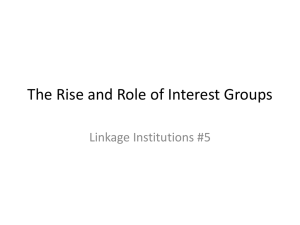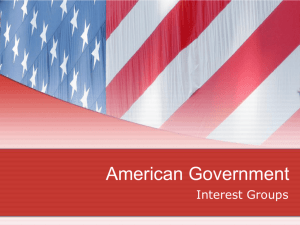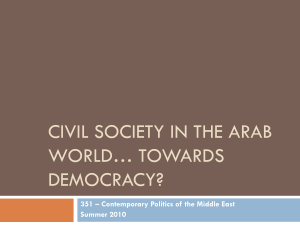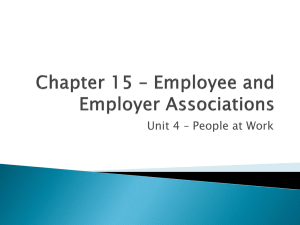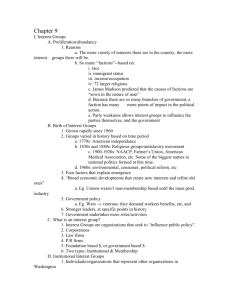interest groups iii
advertisement
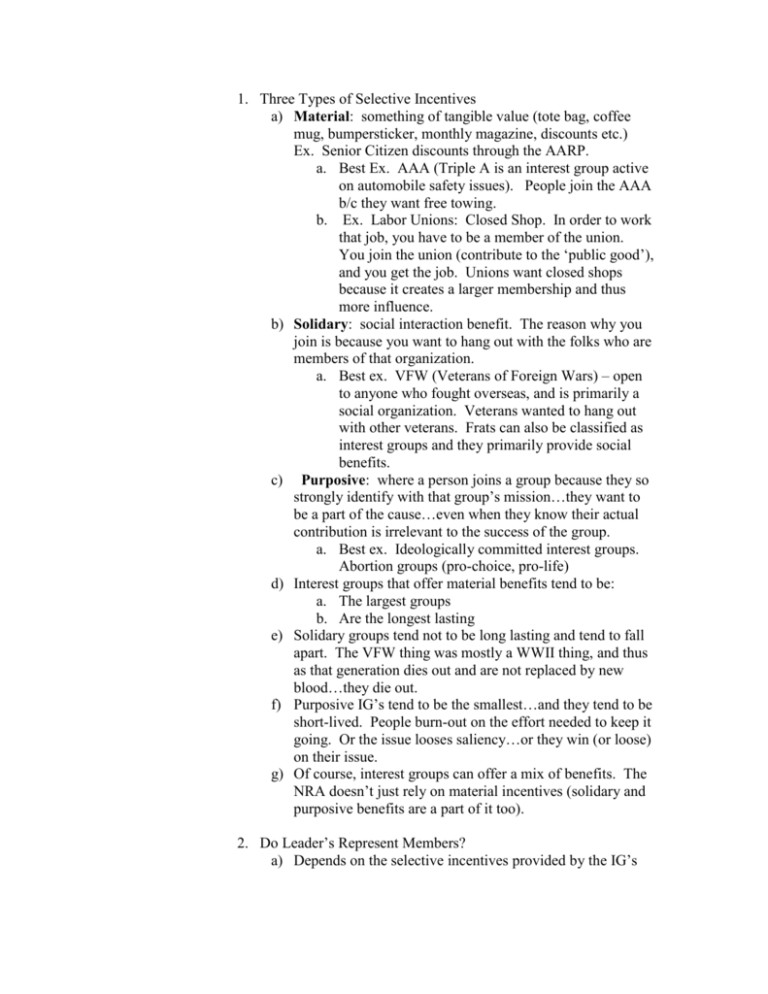
1. Three Types of Selective Incentives a) Material: something of tangible value (tote bag, coffee mug, bumpersticker, monthly magazine, discounts etc.) Ex. Senior Citizen discounts through the AARP. a. Best Ex. AAA (Triple A is an interest group active on automobile safety issues). People join the AAA b/c they want free towing. b. Ex. Labor Unions: Closed Shop. In order to work that job, you have to be a member of the union. You join the union (contribute to the ‘public good’), and you get the job. Unions want closed shops because it creates a larger membership and thus more influence. b) Solidary: social interaction benefit. The reason why you join is because you want to hang out with the folks who are members of that organization. a. Best ex. VFW (Veterans of Foreign Wars) – open to anyone who fought overseas, and is primarily a social organization. Veterans wanted to hang out with other veterans. Frats can also be classified as interest groups and they primarily provide social benefits. c) Purposive: where a person joins a group because they so strongly identify with that group’s mission…they want to be a part of the cause…even when they know their actual contribution is irrelevant to the success of the group. a. Best ex. Ideologically committed interest groups. Abortion groups (pro-choice, pro-life) d) Interest groups that offer material benefits tend to be: a. The largest groups b. Are the longest lasting e) Solidary groups tend not to be long lasting and tend to fall apart. The VFW thing was mostly a WWII thing, and thus as that generation dies out and are not replaced by new blood…they die out. f) Purposive IG’s tend to be the smallest…and they tend to be short-lived. People burn-out on the effort needed to keep it going. Or the issue looses saliency…or they win (or loose) on their issue. g) Of course, interest groups can offer a mix of benefits. The NRA doesn’t just rely on material incentives (solidary and purposive benefits are a part of it too). 2. Do Leader’s Represent Members? a) Depends on the selective incentives provided by the IG’s a. In IG’s that rely on material incentives, there tends to be a low correlation b/w the leaders and the members (leaders don’t tend to represent the attitudes of the members). If you’ve joined for the towing service, it doesn’t mean you agree with their political objectives…in fact you probably don’t even know what their political agenda is. Big reason why Labor Union leadership are Liberal Democrats and the Rank & File Union membership is much more diverse (much more conservative Republicans). b. In IG’s that rely primarily on solidary incentives, in the middle. But people aren’t really joining for political objectives, but there is some correlation. c. In IG’s that rely on purposive incentives, there is the highest correlation between leadership and membership views. If the leadership is supporting political objectives you don’t agree with, then you’ll quit…since the only reason you joined was because of its political objectives. Membership keeps leadership on a ‘short lease’ in these cases. B. Activities of Interest Groups 1. Public Relations: TV campaigns, appearance on news programs, etc. 2. Electionneering: trying to effect who does and who does not get elected. a) Most obvious way: contributing money to candidates that support their issues b) Provide labor for campaigns c) Lobbying: professional representatives of the IG try to convince members of congress to support legislation the IG favors. d) Grassroots pressure (stir up people over a salient issue). The IG tries to get its membership to contact the White House or Congress. II. Types of Interest Groups A. Membership Organizations 1. Peak Business Associations: made up of business associations from a variety of industries a) U.S. Chamber of Commerce: made up of a bunch of smaller business associations b) Don’t come from just one industry (they can be from the banking industry, medical industry, etc.) c) What do they do: 2. 3. 4. 5. a. Active on issues that broadly affect the American economy (macro-economic issues): the big economic issues. Ex. how much taxation we are going to have. Trade Associations: made up of business associations from a single industry a) American Bankers Association b) Bow Tie Manufactures Association Labor Unions – Made up of either other labor unions or workers a) Labor Unions are not nearly as numerous as trade associations, but tend to have larger memberships b) American Federation of Labor – Congress of Industrial Organization (AFL-CIO) : made up of smaller labor unions c) United Mine Workers – made up of miners d) Union of Journeyman Horeshoers – made up of horeshoers e) The UMW & UJH are members of the AFL-CIO f) AFL-CIO is active on a broad range of economic / political issues, while the unions based on workers tend to just be concerned with issues related to their workers (UMW is just concerned with mining issues) Agriculture Groups a) American Farm Bureau Federation (AFBF) – big group that deals with general agricultural policy b) American Soybean Association – made up of soybean farmers and only deals with soybean political issues Professional Associations a) American Medical Association (AMA) – if you are a doctor, you become a member of the AMA. b) Numerous professional associations (Lawyer – ABA, Political scientists: APSA). c) What do they do? a. Keep their professionals up to date on innovations in the profession b. Lobby Congress on issues related to their professions (tort reform is an issue for ABA). c. Ex. In Texas there is the Political Science Employment Act: passed laws making students have to take 2 political science classes in college d. AMA is the most powerful political interest group in the United States. i. Lots of money ii. Large membership (lots of doctors that see a lot of patients) iii. Good on public relations iv. AMA was opposed to the Clinton Health Care plan, and that played a big part in why it failed. 6. Citiznes, Advocacy, Cause Groups (Public Interest Groups) – groups that are not primarily involved in economic activity a) Citizen Groups: are involved in a general issue area. Ex. Sierra Club is involved in a general issue area (environment). b) Advocacy Groups: are lobbying/active in promoting the rights of some other group that cannot represent itself. Ex. Children’s Defense Fun (kids don’t have the assets to lobby politically). Ex. PETA (People for the Ethical Treatment of Animals) Animals can’t lobby congress, contribute money, etc. Ex. Prisoner’s Rights Groups (again, can’t vote, etc.) c) Cause Groups: A group that is a single-issue group. They have a very narrow focus and care only about that issue. Ex. Operation Rescue (anti-abortion) Ex. ACT-UP (AIDS) 7. Civil Rights and Social Welfare Organizations a) Groups that lobby for civil rights issues (NAACP, NOW, etc.) B. Nonmembership Organizations 1. Corporations: legally they are considered a ‘person’…but in some cases they act like an interest group. 2. Public Interest Law Firms: an entity unto itself (doesn’t have ‘members’), but they are politically active as well. Involve themselves in Judicial cases, etc.
